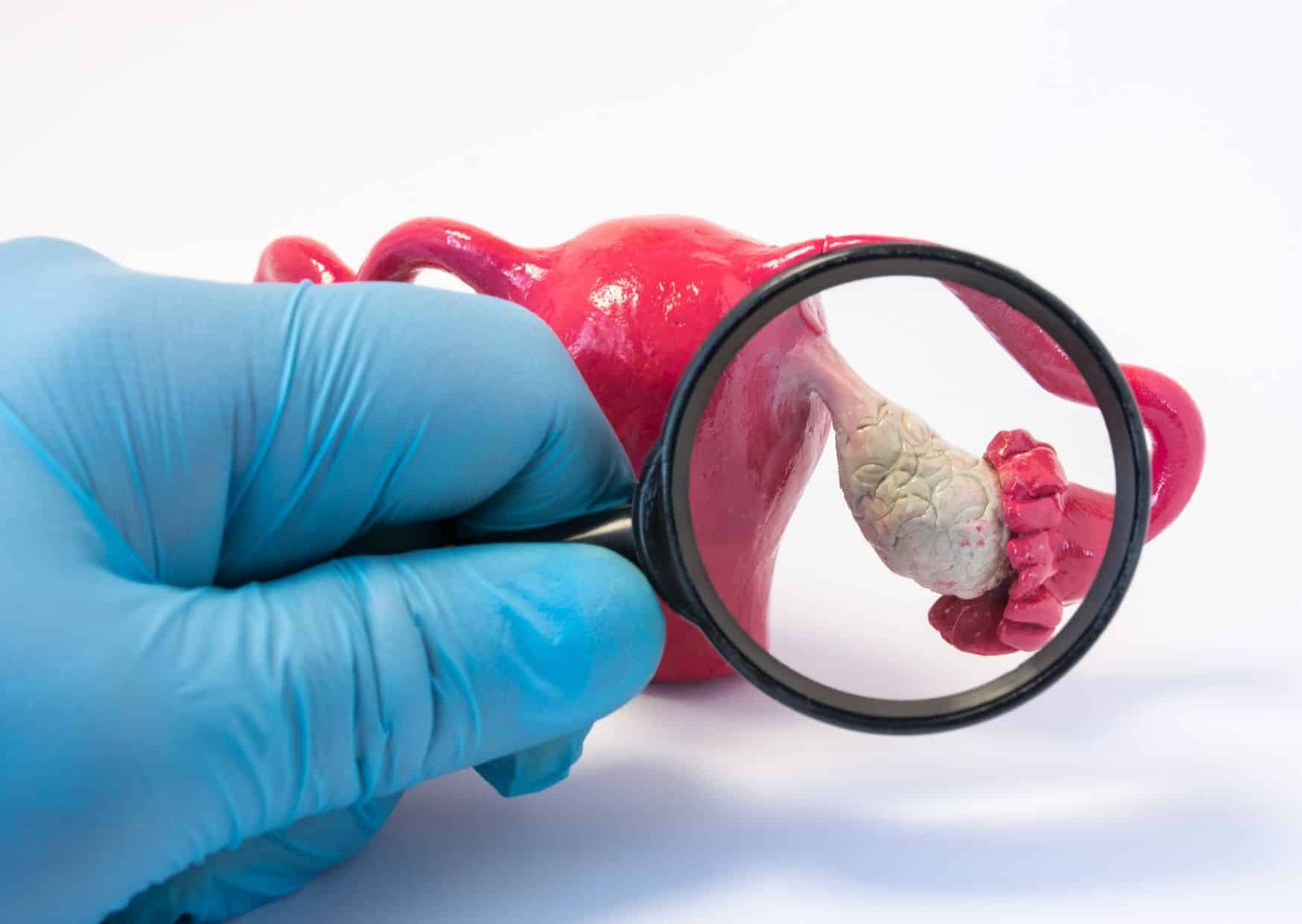PCOS, or polycystic ovarian syndrome, is a medical condition that affects one in ten women. Women with this condition produce higher than normal levels of androgens, which are hormones most commonly found in men. This hormone imbalance causes undesirable effects including infertility, facial hair growth, acne, late or missing periods, and more. The cause of this condition is unknown, and treatments vary from person to person. Those trying to have a child while suffering from this condition generally consider in vitro fertilization to be the ideal way to move forward with starting a family.
Symptoms
Usually, a doctor will look for three key symptoms for a diagnosis of polycystic ovarian syndrome. The first is high androgen levels, which is the most common symptom and one of the driving forces behind this syndrome. The second thing doctors look for is fluid-filled cysts, or lumps, developing on the ovaries. These cysts may or may not be painful, and can burst. Checking for these cysts may be done with ultrasound technology. Lack of cysts does not automatically rule out this disorder. The third symptom doctors look for is irregular or missing periods. Other symptoms, such as facial hair growth, acne, weight gain, and infertility, are generally linked to high androgen levels and are not considered one of the key symptoms for a diagnosis.
Diagnosis
Doctors require at least two of the three symptoms mentioned above to be present in order to diagnose polycystic ovarian syndrome. Getting a diagnosis can help pave the way to treatment of symptoms and may make IVF easier since your clinic will be aware of the pre-existing condition that may cause issues. To find out if you have the three key symptoms, your doctor will likely order a blood test to check your androgen levels, an ultrasound or other exploratory test to look at your ovaries, and may ask you to keep track of your periods for a few months to determine how long they are, how often they happen, and how heavy your flow is. Using this information, your doctor will decide if they believe you have this condition and what the best way to treat it may be.

Treatment
Luckily, polycystic ovarian syndrome is relatively easy to treat, although it cannot be cured outright. The most common course of treatment is hormonal birth control, as this spurs your body to create hormones based on those being provided by the birth control. A multi-hormone type is generally recommended, with pills being the most popular option. Other options may include hormonal shots, rings, patches, or other methods depending on your needs and preferences. Other treatments for polycystic ovarian syndrome are based specifically around the extra symptoms the user shows, with treatments aiming to lower androgen levels, reduce hair loss, treat acne, and more depending on the individual. More extreme treatment options include removal of one or both ovaries, or full uterus removal. However, the disorder can generally be managed without surgery, as surgery completely removes the option to have a child in some cases.
Health Complications
Women with undiagnosed or untreated polycystic ovarian syndrome are at higher risk for developing health issues such as insulin resistance, diabetes, high triglyceride levels, high cholesterol, heart disease, cancer of the inner lining of the uterus, sleep apnea, stroke, and obesity. Because of these risks, it is important to monitor your condition and work towards a healthy lifestyle. Treatment of symptoms may help lower the risk of these complications, and a healthy diet and exercise is strongly encouraged in women with this condition to help keep weight and insulin levels under control.
Fertility and PCOS
Trying to get pregnant with polycystic ovarian syndrome can be very difficult due to the nature of the disorder. Since your body is creating higher than normal levels of androgens, which are hormones usually found in the male body, eggs may not develop and release properly. This may be due to thickened ovary walls, lack of egg development, or other issues. Luckily, there are several treatment options available to those trying to get pregnant while dealing with this disorder. The first option is to lose weight with healthy eating and regular exercise, as this can help regulate your menstrual cycle and ovulation. Weight loss should be gradual and consistent, as crash diets or untested diet supplements may cause rapid weight gain and loss, which may exacerbate the issue. Once weight loss has been started, your doctor may recommend cycle tracking to determine when you are most likely to ovulate.
Another option for those seeking to get pregnant is medication. There are several drugs available that help you ovulate, which is the largest barrier to pregnancy in most women suffering from polycystic ovarian syndrome. Surgical options are available as well, which work to reduce the thickness of the outer layer of ovaries, allowing ovulation to occur more easily. Surgical techniques generally only last for six to eight months, however, and therefore may not be an option for some.
In Vitro Fertilization
IVF, or in vitro fertilization, is the option usually explored if medications do not work. During this procedure, an egg is fertilized in a lab and implanted directly in the uterus. This can help reduce the chances of twins or triplets when compared to prescription based methods, as your doctor has control over how many eggs are implanted in the uterus at once. While more expensive than prescription options may be, in vitro fertilization has the advantage of being more carefully monitored, so you will know if the embryo is viable before implantation.
People with polycystic ovarian syndrome who choose to go through this procedure are not more likely to have difficulties with the pregnancy than those without the disorder, as PCOS only affects the ovaries and does not have a bearing on fertilization or pregnancy. In fact, pregnancy can provide temporary relief of some secondary symptoms of the disorder, such as hair loss or facial hair growth, as your body will be producing hormones in much higher levels than normal.
If you choose to explore IVF, you can expect to have a meeting with your doctor to discuss the procedure. You will need to identify the first day of your period, which your health care team can assist with if your periods are not regular. On day one, you will start taking medications to increase the number of eggs produced in a cycle. This enables your doctor to collect multiple eggs at once, limiting the number of times you must go through collection in order to get a viable embryo. This medication is usually delivered via injection, which you or your partner will do at home. Your doctor will help you learn how to do this properly.
Once your ovaries have produced enough eggs, your doctor will collect them with a needle while you are asleep under a general anaesthetic. This should be a quick procedure and you should be able to go home that day. Your doctor will introduce your chosen sperm (either your partner's or a sperm donor's) to your eggs, and when a viable embryo has been created it will be implanted in you. Your doctor will then take blood samples in about two weeks to confirm if the pregnancy has taken or not. If it has not, you may choose to repeat the procedure.

«Luckily, there are several treatment options available to those trying to get pregnant while dealing with this disorder. One option is to lose weight with healthy eating and regular exercise, as this can help regulate your menstrual cycle and ovulation.»
Advancements
Since polycystic ovarian syndrome affects so many women, there is research constantly being done to find better treatments and potential cures. This research has led to advancements such as using Metformin, a prescription drug generally used to treat type 2 diabetes, to control androgen levels. Metformin's androgen blocking is a side effect, but for those with this disorder it can be the primary reason to take the drug. Researchers are especially interested in discovering why so many women suffer from polycystic ovarian syndrome without a distinct biological marker. Other researchers are focused on creating a consistent, streamlined care plan to make sure all women are treated for their condition in a way that is likely to work.
Support
Coping with polycystic ovarian syndrome can be difficult at times, especially if the condition presents side effects that others can see. Finding a good support system in your community can help. Doctors and nurses are the foundation of this support system, as they are familiar with the condition and can help prepare you for the changes you may see as you try different treatments. Other women in your friend group may also have this condition, and would likely enjoy having someone to support them. Online groups also exist for both polycystic ovarian syndrome and in vitro fertilization, and provide useful eyewitness information and tips that can help you learn to live with the condition and navigate potential fertility treatments.
Overall, having polycystic ovarian syndrome is something that can be worked around, even as you pursue pregnancy. Your doctor will be able to guide you through the options available to you, such as in vitro fertilization, and can prescribe treatments for symptoms. Seeking help with the process is encouraged and can help you become more comfortable with your diagnosis.
